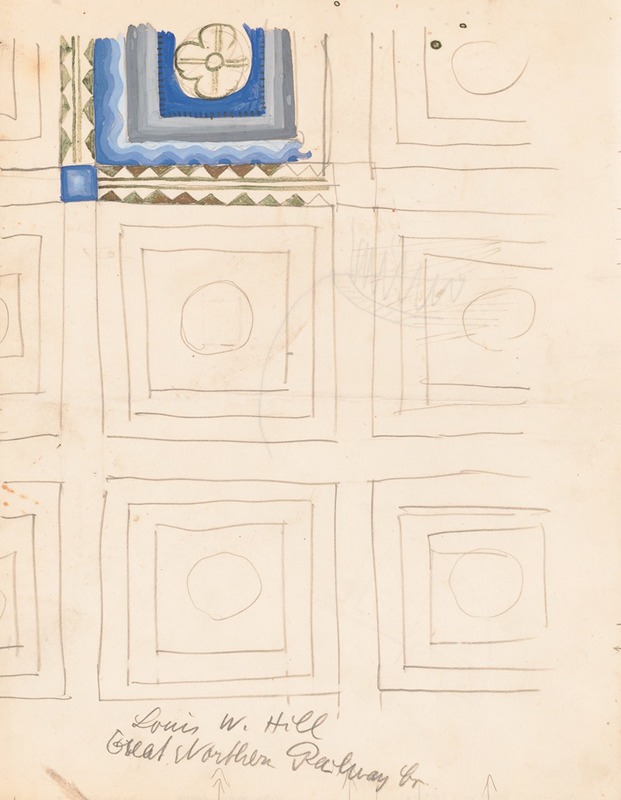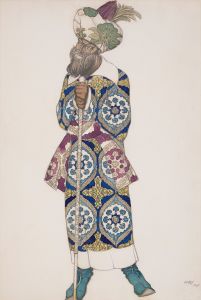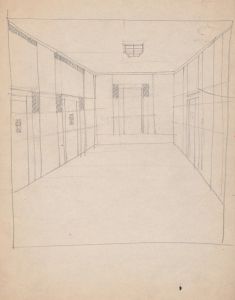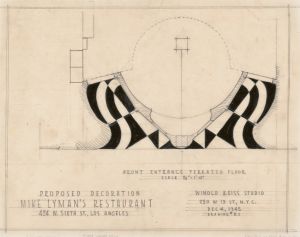
Design for reflected ceiling plan.] [Partially colored drawing for ceiling plan
A hand-painted replica of Winold Reiss’s masterpiece Design for reflected ceiling plan.] [Partially colored drawing for ceiling plan, meticulously crafted by professional artists to capture the true essence of the original. Each piece is created with museum-quality canvas and rare mineral pigments, carefully painted by experienced artists with delicate brushstrokes and rich, layered colors to perfectly recreate the texture of the original artwork. Unlike machine-printed reproductions, this hand-painted version brings the painting to life, infused with the artist’s emotions and skill in every stroke. Whether for personal collection or home decoration, it instantly elevates the artistic atmosphere of any space.
Winold Reiss was a German-American artist and designer known for his work in various artistic fields, including portraiture, graphic design, and interior decoration. Born in Karlsruhe, Germany, in 1886, Reiss immigrated to the United States in 1913, where he became a prominent figure in the American art scene. He is particularly noted for his contributions to modernist design and his efforts to incorporate diverse cultural elements into his work.
The "Design for Reflected Ceiling Plan" is one of Reiss's works that showcases his skill in interior design and architectural planning. A reflected ceiling plan is an architectural drawing that shows the items located on the ceiling of a room or space. It is essentially a mirror image of the floor plan, providing a view of the ceiling layout, including elements such as lighting fixtures, decorative features, and structural components.
Reiss's approach to design was heavily influenced by his background and training in Europe, where he was exposed to various art movements, including Art Nouveau and the Vienna Secession. His work often reflected a blend of these European influences with American themes and motifs. Reiss was particularly interested in the use of color and geometric patterns, which became a hallmark of his design style.
In the context of a reflected ceiling plan, Reiss's use of color and pattern would have been employed to enhance the aesthetic appeal of the space, creating a harmonious and visually engaging environment. His designs often incorporated bold colors and intricate patterns, which were intended to complement the overall architectural style of the building.
Reiss's work in interior design extended beyond ceiling plans. He was involved in numerous projects that included murals, furniture design, and complete interior schemes. One of his most notable projects was the design of the interiors for the Cincinnati Union Terminal, a landmark Art Deco train station completed in 1933. For this project, Reiss created a series of large mosaic murals depicting the history of Cincinnati and the surrounding region, showcasing his ability to integrate art and architecture seamlessly.
Throughout his career, Reiss was committed to celebrating cultural diversity through his art. He was known for his portraits of Native Americans and African Americans, which were characterized by their respectful and dignified representation of the subjects. This commitment to diversity and cultural appreciation was also evident in his design work, where he often drew inspiration from a wide range of cultural sources.
Reiss's contributions to design and art were significant during his lifetime, and his work continues to be appreciated for its innovative approach and cultural sensitivity. His designs for reflected ceiling plans and other architectural elements remain a testament to his skill as a designer and his ability to blend artistic expression with functional design.
In summary, Winold Reiss's "Design for Reflected Ceiling Plan" exemplifies his expertise in interior design and his distinctive use of color and pattern. His work reflects a fusion of European artistic influences with American themes, and his commitment to cultural diversity is evident in both his art and design projects. Reiss's legacy as an artist and designer endures, with his work continuing to inspire and influence contemporary design practices.






![Design drawings for the Theodore Weicker Apartment Building.] [Study for metalwork gate](/imgs/249281/s/winold-reiss-design-drawings-for-the-theodore-weicker-apartment-building-study-for-metalwork-gate-8a05d5e9.jpg)
![Design for fine art print, ‘Three Figures’.] [Expressionist scene with African influence](/imgs/249288/s/winold-reiss-design-for-fine-art-print-three-figures-expressionist-scene-with-african-influence-54464834.jpg)
![Designs for promotional material for opera singer Emanuel List.] [Drawing for brochure page](/imgs/249318/s/winold-reiss-designs-for-promotional-material-for-opera-singer-emanuel-list-drawing-for-brochure-page-3320265e.jpg)
![Designs for unidentified restaurant or bar interiors.] [Color study of bar, showing elevations with turquoise and vermillion decorations with tropical theme, no. 1](/imgs/249335/s/winold-reiss-designs-for-unidentified-restaurant-or-bar-interiors-color-study-of-bar-showing-elevations-with-turquoise-and-vermillion-decorations-with-tropical-theme-no-1-cec5c0ed.jpg)
![Drawings for proposed decorations of Mike Lyman’s Restaurant, 424 W. Sixth St., Los Angeles, CA.] [Color scheme for ceiling, playroom – bar – foyer](/imgs/249337/s/winold-reiss-drawings-for-proposed-decorations-of-mike-lymans-restaurant-424-w-sixth-st-los-angeles-ca-color-scheme-for-ceiling-playroom-bar-foyer-ba71c61c.jpg)
![Drawings for proposed decorations of Mike Lyman’s Restaurant, 424 W. Sixth St., Los Angeles, CA.] [Drawing #8, playroom elevation N and O](/imgs/249339/s/winold-reiss-drawings-for-proposed-decorations-of-mike-lymans-restaurant-424-w-sixth-st-los-angeles-ca-drawing-8-playroom-elevation-n-and-o-2e0cd08a.jpg)
![Exhibit design with stage in form of folding screen.] [Sketch of exhibit with modern chairs and tables](/imgs/249343/s/winold-reiss-exhibit-design-with-stage-in-form-of-folding-screen-sketch-of-exhibit-with-modern-chairs-and-tables-b25d6d6d.jpg)
![Graphic designs for Fortune magazine.] [Studies for cover drawn on black paper](/imgs/249355/s/winold-reiss-graphic-designs-for-fortune-magazine-studies-for-cover-drawn-on-black-paper-4ae65d38.jpg)
![Interior design drawings for unidentified rooms.] [Sketch for interior, possibly hotel lobby](/imgs/249361/s/winold-reiss-interior-design-drawings-for-unidentified-rooms-sketch-for-interior-possibly-hotel-lobby-c271d10.jpg)
![Interior design sketches for Alamac Hotel, 71st and Broadway, New York, NY.] [Incomplete interior perspective of a hallway](/imgs/249365/s/winold-reiss-interior-design-sketches-for-alamac-hotel-71st-and-broadway-new-york-ny-incomplete-interior-perspective-of-a-hallway-e54f10f2.jpg)

